15 Best External Hard Drives for RAID in 2025
RAID (Redundant Array of Independent Disks) configurations have become a cornerstone for those seeking enhanced performance, redundancy, and data protection. As we step into 2025, the market for external hard drives tailored for RAID setups is flourishing with diverse options catering to various needs. Whether you're a creative professional managing vast multimedia files or a business ensuring robust backups, selecting the right external hard drive is pivotal. In this article, we delve into the 15 best external hard drives for RAID, highlighting exceptional speed, durability, and storage capacity to help you make an informed decision for your data storage needs.
Why Choose an External Hard Drive for RAID?
Opting for an external hard drive for RAID (Redundant Array of Independent Disks) offers a wealth of benefits that cater to both personal computing and professional demands, and understanding these advantages can greatly enhance your data management strategy.
What is a RAID hard drive and why one need to use it? One of the primary reasons to choose an external hard drive for RAID is its portability. Unlike internal drives that are fixed within a computer system, external hard drives can be easily transported, allowing you to access your data across different locations and devices without hassle. This mobility is particularly beneficial for professionals who need to transfer large media files, backups, or work on collaborative projects in various settings.
RAID configurations themselves are designed to provide several advantages, most notably data redundancy and improved performance. By using multiple disks in tandem, RAID setups can mirror your data, ensuring that if one drive fails, your information remains safe and accessible. This level of redundancy significantly reduces the risk of data loss, offering peace of mind for users with critical data storage needs.
Moreover, depending on the RAID level chosen, users can also experience enhanced read and write speeds. For instance, RAID 0 can split data across multiple disks for faster access times, which is ideal for high-performance tasks such as video editing or gaming. Meanwhile, other configurations like RAID 1, though focusing on redundancy, still offer satisfactory performance improvements for everyday applications.
In terms of scalability, external hard drives provide an easy path for expanding your storage setup. As your data storage needs grow, you can simply add more drives to your existing RAID configuration, avoiding the complexities and downtime associated with upgrading internal storage components.
Lastly, it's important to note the diversity in the market for RAID-compatible external drives. Users can choose from a range of options that vary in terms of storage capacity, speed, durability, and price, allowing them to tailor their selection to meet specific requirements and budget constraints. Learn more about setting up RAID drives.
Ready to get your data back?
To recover data from RAID drive (documents, databases, images, videos, and other files from RAID 0, RAID 1, 0+1, 1+0, 1E, RAID 4, RAID 5, 50, 5EE, 5R, RAID 6, RAID 60, RAIDZ, RAIDZ2, and JBOD), press the FREE DOWNLOAD button to get the latest version of DiskInternals RAID Recovery® and begin the step-by-step recovery process. You can preview all recovered files absolutely for free. To check the current prices, please press the Get Prices button. If you need any assistance, please feel free to contact Technical Support. The RAID recovery service team is here to help you to rebuild RAID and get your data back!
How to Choose the Best RAID External Hard Drive?
Selecting the ideal RAID external hard drive involves careful consideration of several key factors to ensure that it meets your specific needs and performance expectations.
First, consider the storage capacity you require. Assess your current data needs and anticipate future growth to ensure the drive provides ample space. Whether you need a few terabytes for personal use or several dozen terabytes for business, choosing the right capacity is crucial.
Next, evaluate the RAID level that suits your goals. Different RAID levels offer varying balances between performance, redundancy, and storage efficiency. RAID 0 provides enhanced speed but no redundancy, RAID 1 offers data mirroring for safety, and RAID 5 or 6 can provide both speed and redundancy with a minimum of three and four disks, respectively.
The connectivity options available are also important. Look for drives with the latest interfaces like USB 3.2, Thunderbolt 4, or eSATA, which offer faster data transfer rates and broader compatibility with modern devices. This is especially critical if you're dealing with large files and need high-speed access.
Consider the build quality and durability of the drive. Opt for models that are known for robust construction and have features like shock resistance if you need them for off-site work or travel. A well-built drive ensures longevity and reliability, protecting your data investment.
Speed and performance metrics should align with your usage patterns. Check for the drive's RPM (revolutions per minute) or, if it's an SSD-based RAID, the read and write speeds. Higher speeds translate into better performance, especially when dealing with large data sets or complex computing tasks.
Finally, factor in the cost and warranty. While higher-end options might come with a steep price tag, they often include features like extended warranties and better support. It's essential to weigh the benefits against your budget to find a drive that offers the best value for your investment.
Note: RAID 0 vs RAID 10 and RAID 4Top 15 Best External Hard Drives for RAID in 2025
Here is our carefully combined listicle of the best external hard drives to use for RAID setup in 2025.
1. LaCie RAID - Best for Professionals
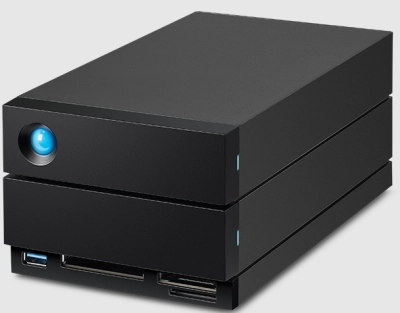
LaCie 2big RAID combines dual-drive performance with hardware RAID and up to 48 TB capacity, delivering sequential reads up to 550 MB/s in RAID 0 configuration. Its rugged aluminum enclosure and enterprise-grade drives ensure longevity and resilience in demanding workflows.
Pros
- Robust performance with dual drives offering up to 48 TB
- Enterprise-grade build and reliability
- Readily available for RAID 0 and RAID 1 setup
- Supports USB-C: USB4, USB 3.0, Thunderbolt 4, and Thunderbolt 3.
Cons
- Expensive price point
- Bulky design
Rating: 4.2/5
2. Western Digital My Book Duo - Best for Home Use
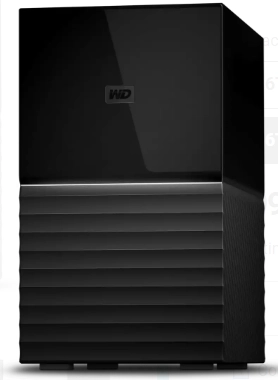
If you’re looking for a heavy-duty external hard drive setup, here’s one for you. The WD My Book Duo packs two sturdy WD Red drives into a single enclosure with hardware RAID 0 or 1 presets, delivering fast performance and a convenient built-in USB hub. Its plug-and-play design simplifies setup for home backups, while hot-swap drive bays offer easy drive replacement for your configurations.
Pros
- Hardware RAID- ready with integrated USB 3.0 hub
- Easy drive replacement via hot swapping
- Up to 40TB storage offering
- Supports JBOD configuration
- 3-year limited warranty
Cons
- Hefty design
- No Thunderbolt support
Rating: 4.0/5
3. G-Technology G-RAID with Thunderbolt 3 – Best for Mac Users
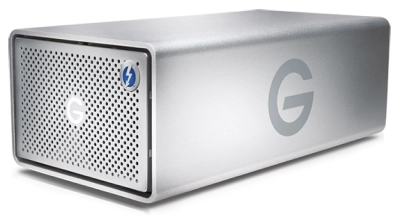
Talk about a sleek external hard drive for RAID, and you have the G-RAID with Thunderbolt 3 system. This sturdy enclosure offers solid real-world performance, though it exhibits some vibration and noise under heavy load. It is seamlessly compatible with Mac systems and can handle 8K video editing workflows.
Pros
- Thunderbolt 3 connectivity with high sustained throughput
- Highly configurable RAID options
- Sleek and portable design
- Up to 38 TB capacity and 500 MB/S
Cons
- Noticeable vibration and noise under heavy loads
- Quite costly
Rating: 4.3/5
4. Synology DX517 – Best for NAS Expansion
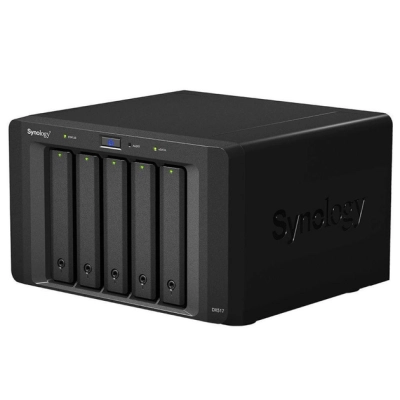
Basically, this is for extension purposes. The Synology DX517 is a dedicated five-bay expansion unit that connects via eSATA, seamlessly adding drive bays to your compatible Synology NAS units without new hardware costs. This works best if you’re trying to extend the storage capability of your existing NAS-based RAID configuration.
Pros
- Supports hot swapping
- Seamless integration with Synology NAS systems
- Robust build and easy setup
- Multiple additional drive arrays for storage expansion
Cons
- Pretty much expensive
- eSATA connection limits throughput (~300 MB/s)
Rating: 3.9/5
5. Seagate IronWolf Pro RAID - Best for Business Backup
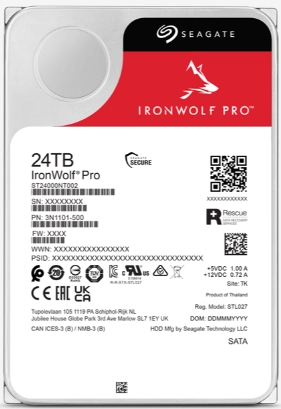
For regular on-site and offline backups to protect your company data, the Seagate IronWolf Pro series is a good deal. The series boasts NAS-optimized HDDs engineered with AgileArray for optimized RAID performance and a workload rating of up to 550 TB/yr.
Pros
- Up to 5 years warranty (limited)
- High workload ratings
- RAID-optimized AgileArray firmware with support for dual-plane balancing
- Fast processing speed
Cons
- This is just a product series of single-disk storage drives with no in-device RAID hardware
- You have to purchase an enclosure case alongside
Rating: 4.1/5
6. OWC Mercury Elite Pro Dual - Best Budget Option
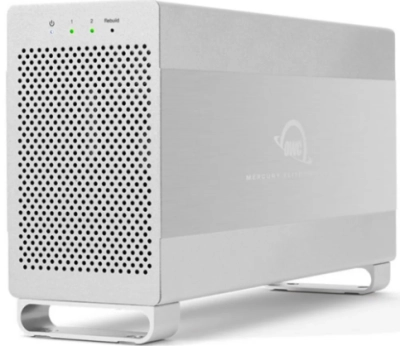
Here’s quite an affordable alternative to the expensive ones listed above. The OWC Mercury Elite Pro Dual offers two drive bays with hardware RAID 0, 1, and JBOD presets. It also supports USB 3.2 Gen 2, but without Thunderbolt support. You can get this for your entry-level DAS setups and enjoy good speeds—407MB/S
Pros
- Affordable pricing at under $150
- Hardware RAID support with versatile modes
- High-speed USB 3.2 (5Gb/s) + eSATA ports
- Sturdy aluminum build with a quiet cooling fan
Cons
- No Thunderbolt support
Rating: 3.8/5
7. Buffalo TeraStation 3410DN - Best for Small Offices
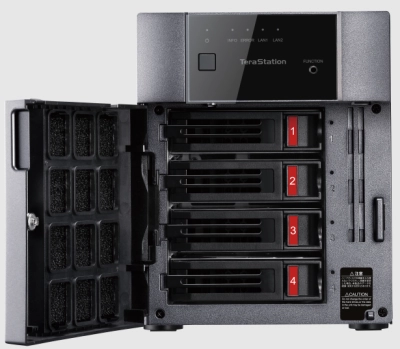
Buffalo TS3410DN 4-bay NAS, rated 83% by TweakTown, is a fully-populated NAS with preloaded drives, offering RAID 0, 1, 5, 6, and 10 support and Gigabit Ethernet for easy small-office deployment. The robust system offers a maximum 16TB storage capacity with a 1.4GHz processor—it can serve for JBOD configurations, too.
Pros
- Quick RAID setup with pre-tested drives
- Comprehensive warranty and 4-bay flexibility
- Multiple connectivity options
- Up to 5 Gbps transmission rate
Cons
- Outclassed in performance by newer NAS systems
- Each drive bay can only contain a 4 TB drive maximum
Rating: 3.7/5
8. SanDisk Professional G-RAID Shuttle 4 - Best for Large Storage Needs
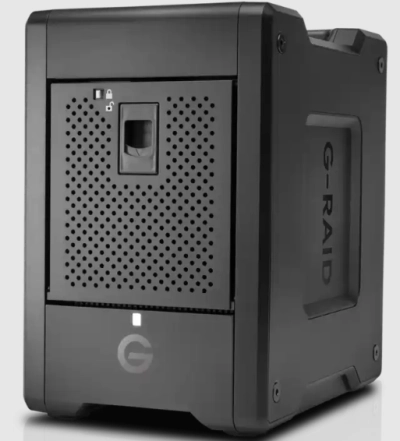
A rigid gear to complement your workflow as an enthusiast home user, and a superior workhouse for enterprises. The SanDisk G-RAID Shuttle 4 features dual Thunderbolt 3 ports and user-upgradeable drives, delivering up to 2800 MB/s in RAID 0 and capacities up to 72 TB with daisy-chain support for pro-level workflows.
Pros
- Can be used to set up multi-stream 4K, 8K, and VR workflows, RAID 0, 1, 5, and 10
- High burst transfer rates via Thunderbolt 3
- User-replaceable drives with expandable capacities
- 5-year limited warranty
- Good design appearance
Cons
- Steep starting price (over $600) for base models
- Primarily targeted at Mac users
Rating: 4.4/5
9. TerraMaster D5-300C - Best for Expandability
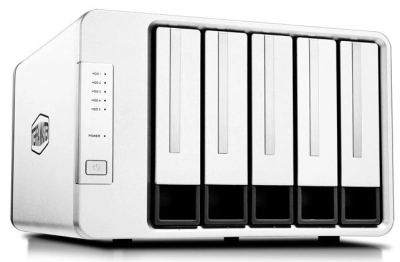
The TerraMaster D5-300C provides 2+3 RAID storage, which means it offers a 5-drive bay that is structured to operate as a 2-drive bay and a 3-drive bay, all in one system. So, you can have a 2-drive RAID 0 or RAID 1, as well as a 3-drive RAID 5 or JBOD on this system. TerraMaster D5-300C inarguably offers maximum flexibility at a decent price.
5-bay RAID enclosure supports RAID 0 and 1, offering up to 80 TB capacity with USB 3.1 Gen 1 connectivity and a $199 MSRP.
Pros
- Five-bay capacity in a compact chassis
- Good price
- Classic flexibility
- Supports up to 100 TB capacity
Cons
- Lack of fine-grained controls
- The USB 3.1 Gen 1 bandwidth limits the performance per drive
Rating: 3.9/5
10. Netgear ReadyNAS 424 - Best for Data Protection
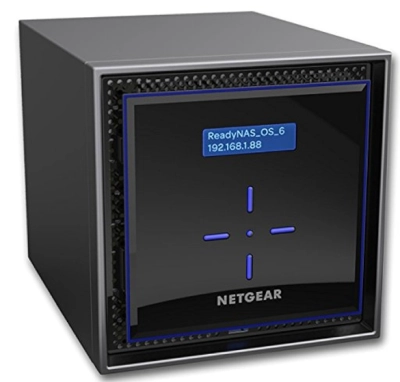
NETGEAR ReadyNAS 424 combines Intel Atom C3338 with 2 GB RAM and supports unlimited snapshots for robust data protection in educational or SOHO environments. It stands out as a perfect choice for small businesses. The system is rigidly built and equipped with a good number of feature sets as an all-rounder NAS for small businesses and individual users.
Pros
- Unlimited snapshot capability for versioned backups.
- Solid build and intuitive interface.
- Pretty compact design
- Comes ready to use outside the box
Cons
- Netgear has discontinued the product line
- Lacks modern transcode-capable CPU for media servers
Rating: 4.0/5
11. Drobo 5D3 - Best for Automated RAID Management
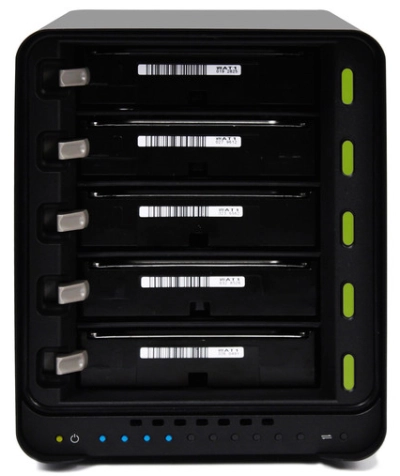
Built for professional content creators and heavy media handlers, the Drobo 5D3 is a five-bay Thunderbolt 3 DAS designed for simple RAID management via BeyondRAID, requiring no RAID expertise and offering tool-less expandability. Offering a 128 GB mSATA SSD, and a five-year drive recovery service plan from DriveSavers, this could be your best bet for an external hard drive RAID system.
Pros
- Offers up to five 3.5-inch SATA drive bays that support 3.5/2.5-inch SATA drives and SSDs.
- Plug-and-play BeyondRAID software for automatic drive management
- Compact design with mSATA cache support
- The Thunderbolt 3 ports also deliver 15W charging power
Cons
- Audible fan noise and lack of Thunderbolt 3 on Windows
- High entry price point
Rating: 3.8/5
12. ASUS ROG Strix Arion – Best for Gamers
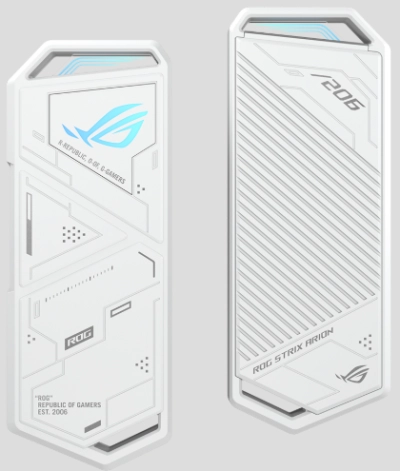
A premium metal chassis with ARGB lighting and tool-less NVMe installation, delivering near-SSD speeds over USB 3.2 Gen 2 (10 Gbps) with excellent thermal pads. ROG Strix Arion offers dual USB-C to C and USB-C to A cables, with transfer speeds reaching 10 Gbps, as well as have native support for M.2 PCIe NVM Express SSDs.
Pros
- Robust build with ARGB lighting appeal
- High-speed Gen 2 USB performance and thermal management
- Aluminum alloy case
- Truly sleek aesthetics
Cons
- Expensive price
- Limited to one M.2 drive
Rating: 3.7/5
13. QNAP TR-004 - Best for Hybrid RAID Setup
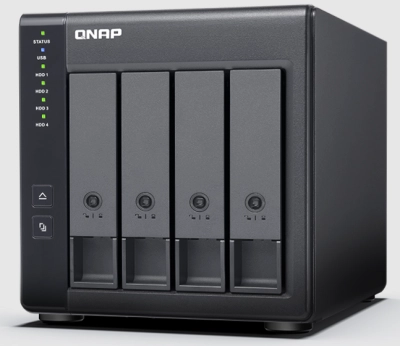
This is an enclosure that lets you extend the capacity of your RAID setup or JBOD storage; it adds up to four drives via USB 3.2 Gen 2 with hardware RAID 0, 1, 5, 10, and JBOD preset configurations. The QNAP TR-004 offers versatile backups or DAS expansion for PCs and NAS, with easy RAID mode selection and flexibility.
Pros
- Flexible built-in hardware RAID levels
- Flexible compatibility with Windows, Mac, Linux, and NAS
- Up to 5 Gbps USB 3.2 Gen 1 throughput per link
- Disk mode DIP switch
Cons
- Non-server versions of Windows have a 63 TB limit for a single volume
Rating: 4.1/5
14. WD Red Pro RAID - Best for Heavy Workloads

This pretty compact hard drive offers up to 272MB/S speed for 26 TB capacity and is optimized for RAID setup. The WD Red Pro drives are NAS-optimized with RAID error recovery control, a workload rating of up to 550 TB/yr, and robust 7200 RPM performance for multi-bay RAID environments.
Pros
- RAID-ready firmware
- High-capacity options up to 26 TB for dense arrays
- Good speed
Cons
- Internal HDD model; requires external enclosure for DAS use
- Enterprise-level pricing
Rating: 4.2/5
15. Icy Dock ToughArmor MB998SP-B - Best for Enterprise Users
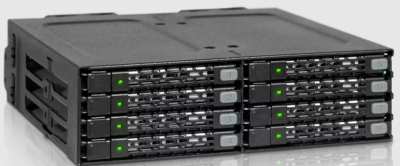
Talk about a rugged-built, tough system for the harshest conditions and you have the ICY DOCK ToughArmor MB998SP-B. This external hard drive enclosure can contain up to eight 2.5-inch drives in a single 5.25″ bay with a metal chassis and smart fan control for enterprise or dense storage applications. While fan noise can be noticeable, the switchable low/high settings and tool-less tray design deliver unmatched flexibility.
Pros
- Eight hot-swap bays in one optical bay
- Sturdy full-metal build with adjustable fan control
- Ideal for non-RAID JBOD storage
Cons
- You will deal with fan noise at higher speeds
- Doesn’t work with standalone drives inside the chassis.
Rating: 3.9/5
Need to Verify Your RAID Setup?
Use our RAID Calculator to quickly understand your array configuration and find the best recovery approach. It’s simple, accurate, and can save you valuable time before starting data recovery.
Conclusion
Selecting the right RAID external drive will boost your productivity and foster a managed environment. For mission-critical professional environments, it’d be best to go for the systems with built-in RAID management flexibilities and hot swapping. Notwithstanding, all the hardware here is sturdily built and reliable. Furthermore, make sure to have professional freeware RAID recovery software at hand, for days when things go south.
